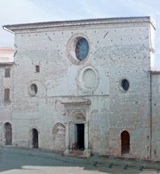
According to tradition, this church was built in 1120, after the Emperor Henry IV lifted a siege of the town.
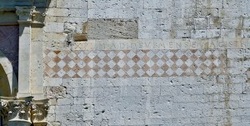
The fragmentary inscription on the facade (to the right of the portal, abve the frieze of pink and white stines) reads: “... XRI MADIO SUB MENSE MAGISTRI”: surviving transcriptions of the complete version record it as: "Anno milleno centeno cepta viceno / sub anno Christi, madio sub mense, magistri", which confirms the date 1120.
Pope Alexander III installed a prior and six canons at San Lorenzo in 1160, and the presence of a prior here is documented in 1191 and again in 1198, when Pope Celestine III confirmed the election of Prior Alberic in 1198. Soldiers of the Emperor Frederick II damaged the church in 1239. It was rebuilt and extended in 1281-5, when the aisles were added to the sides of the nave.
According to evidence presented by witnesses in 1293, Pope Gregory IX had consecrated the high altar of the church in 1228 and granted indulgences to those attending. (Although this is usually accepted at face value, it is noteworthy that the claim was made for the first time two years after Pope Nicholas granted extensive indulgences in respect of Sant’ Andrea).
St Bernardino of Siena preached the Lenten sermon at San Lorenzo in 1438. The Baglioni family provided two priors during the period in which they controlled Spello:
-
✴Gentile Baglioni, from 1498 (whose arms are on furniture (1525) in the Sacristy) [until his murder in 1527?]; and
-
✴Leone Baglioni, the illegitimate son of Gian Paolo Baglioni, from 1528 until 1539. He led the unsuccessful defense of Spello against Imperial soldiers in 1529.
Pope Sixtus IV visited the church in 1476, and his nephew, Pope Julius II visited it in 1507, at which time Gentile Baglioni was Prior. Pope Paul III visited it in 1534, and commissioned the vaulting of the roof and the re-modeling of the facade (see below), which was completed in 1540.
Pietro Ambrosini, the Prior of San Lorenzo, consecrated the new church of Santa Barbara in 1571.
Exterior
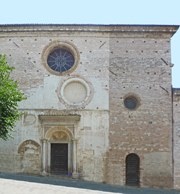
The phases of the construction and reconstruction of the church are visible on is facade:
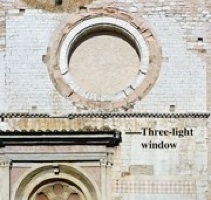

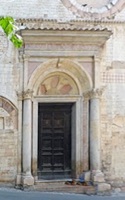
-
✴The large closed rose window, the cornice below, the closed three-light window that is nearly covered by the present portal and the frieze of pink and white stone almost certainly belong to the original façade. The original entrance was probably in line with this rose window, and it probably opened into a single-naved interior.
-
✴The small closed rose window and the entrance to the left of the present portal probably belong to the re-modeling of 1281-5, when aisles were added to the sides of the nave.
-
✴The three open rose windows and the present main portal date to the re-modeling of 1534-40.
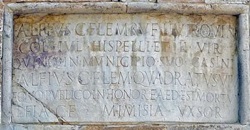
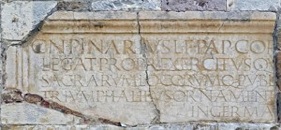
CIL XI 5278 CIL XI 5271
The façade contains two Roman inscriptions that probably date to the period after the formation of the Roman colony, which were embedded here in the late 15th century by Benedetto Urbani:
-
✴An inscription (CIL IX 5278) commemorates:
-
•Caius Alfius Rufus, son of Caius and member of the Lemonia tribe, who was duovir quinquennalis of the Colonia lulia Hispellum after having held that post in his native Casinum;
-
•Caius Alfius Quadratus, son of Caius and member of the Lemonia tribe, [who was a seviri and knight, and then, at the time of his death, aedile];
-
•Alfia, daughter of Caius, who must have been the sister of Alfius Rufus and Alfius Quadratus; and
-
•Mimisia, his wife of one of them, who probably came from Assisi.
-
Caius Alfius Rufus could well be the person who is also recorded in a fragmentary inscription that is now in San Claudio, who was a patron of the amphitheatre.
-
✴An inscription (CIL IX 5271) in honour of Gnaeus Cornelius Pinarius Clemens, a soldier in the service of the Emperor Vespasian (69-79 AD).
A third funerary inscription (CIL XI 5322) that was found nearby, which commemorates Cilus, a freedman of Caius Lanuvius, is now in Palazzo Bianconi.
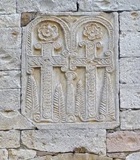
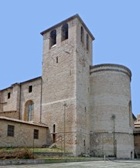
Interior
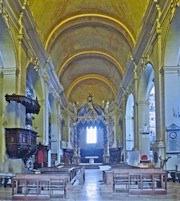
The gilded wooden baldachin (1631) over the high altar is a copy of the one that Gian Lorenzo Bernini designed for St Peter’s in Rome.
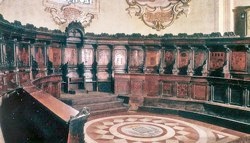
The remarkable inlaid choir stalls (1530-4) in the apse were carved by Andrea Campano da Modena. Payments for the cartoons were made to a number of artists, including Pompeo Cocchi and Febo Melanzio da Montefalco.
The gilded wooden pulpit (1600) by Francesco Costantini, which is on the second pillar on the left, includes a relief of the martyrdom of St Laurence.
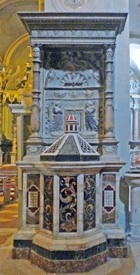
-
✴a tabernacle for holy oil (16th century) from San Severino; and
-
✴the font (1607) by Cruciano Egidiucci da Bettona.
St Bernardino of Siena (15th century)
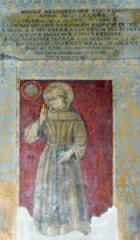
Madonna and Child (15th century)
According to tradition, St Bernardino presented this wooden statue to San Lorenzo during his visit of 1438. It is now in the Cappella dell’ Incoronata (the 1st on the right).
Mystic marriage of St Catherine of Alexandria (1435)
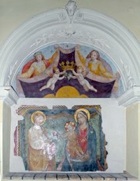
Madonna and Child with saints (ca. 1540)
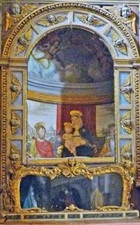
Works by Francesco da Castello
Francesco da Castello (Frans van de Kasteele), who came from Brussels and established an important workshop in Rome, signed and dated the panels on the altars at the ends of the aisles, which were sent to Spello from Rome::
-
✴Christ and the Virgin receive souls from purgatory (1599)
-
This interesting altarpiece is on the Altare della Madonna del Carmine, at the end of the right aisle. It was probably commissioned by Giulio Diamante, who endowed the altar.

-
-
-
-
-
-
✴Martyrdom of St Catherine of Alexandria (1601)
-
This altarpiece, which was originally on what is now the Altare di San Felice, at the end of the left aisle. Monsignor Girolamo Bevilacqua da Spello, the titular Archbishop of Nazareth, who commissioned the altar, is portrayed in the altarpiece. It was moved to the altar in the 3rd bay on the right wall in the 18th century, to make way for the present altarpiece (see below). However, associated panels by Francesco da Castello that depict three scenes from the life of St Catherine remain in their original locations.
Martyrdom of St Felix (1637)

Taddeo Donnola, the Prior of San Lorenzo, probably commissioned this panel after he succeeded in having St Felix named as the sole patron saint of Spello in 1629. He had published a monograph in 1620 entitled: “De loco martyrii sanctii Felicis episcopi spellatensis” (About the place of martyrdom of St Felix, Bishop of Spello) and he also placed an inscription on the facade of San Fedele that claimed this as the place in question. In the panel, the martyrdom takes place in front of a huge statue of Venus, which is a reference to the fact that the remains of a Roman temple dedicated to Venus had been found during the construction of Villa Fidelia in ca. 1600.
St Francis and two angels (1646)
This fresco on the 3rd pilaster on the right, which is dated by inscription, is attributed to Marcantonio Grecchi. [Iconography?] The Latin inscription includes the phrase “Tu in Christo atque in te Christus ..” (You in Christ and Christ in you ..), which is a reference to St Francis as “Alter Christus” (another Christ).
Nativity (1648)
Taddeo Donnola, who was prior of San Lorenzo, commissioned this altarpiece for the Altare del Riscatto. It is attributed to Andrea Camassei. It was removed from the altar in the 1970s, to reveal a fresco attributed to Dono Doni (see above). [Where is it now?]
Altare di San Lorenzo (ca. 1670)
The stucco decoration of this altar (the 2nd on the left), is attributed to Agostino Silva.
Cappella del Sacramento (1793)
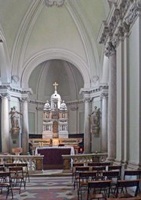
Filippo Neri da Foligno built the this chapel (the 2nd on the right) to a design by Giuseppe Piermarini.
St Antony Abbot (1518)
This altarpiece, which is attributed to Tiberio d’ Assisi, is dated by inscription.
Tabernacle (1587-90)
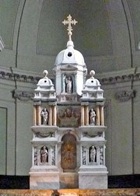
Panels (1589)
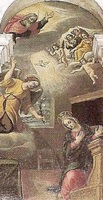
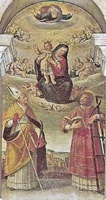
These panels to the sides of the altar in this chapel were sent from Rome to Spello in 1589. They are attributed to the young Marcantonio Grecchi. They depict:
-
✴the Annunciation; and
-
✴the Madonna and Child in glory, with God the Father above and SS Felix and Laurence to the sides.
Sacristy
Prior Benedetto Urbani built the sacristy in 1453 on the foundations of the old church of Sant' Ercolano.
The sacristy contains three pieces of inlaid furniture by Andrea Campano da Modena:
-
✴a chest commissioned in 1522 , which was executed in 1524-26;
-
✴a larger chest with an inscription that records its completion in 1525, which bears the arms of Bishop Francesco Eroli of Spoleto, the Prior Gentile Baglioni and the Bianchi family, who probably financed the commission; and
-
✴a third chest that was intended to hold archival material, which was completed in 1530. Giannicola di Paolo provided the cartoons for the figures of Noah, Moses and Zacharius.
Raccolta Parrocchiale
Crucifix (14th century)
This engraved enamel Crucifix is attributed to Paolo Vanni da Perugia. [Another Crucifix that is signed by this craftsman, which came from Santa Maria Maggiore, is now in the Pinacoteca Comunale.]
Scenes from the life of St Laurence (1566-77)
These six panels were commissioned to form a frieze under the organ. One of them, which depicts the martyrdom of St Laurence, is signed by Nicolò Circignani, il Pomarancio and dated by inscription.
St Laurence and two angels (16th century)
This altarpiece is attributed to a follower of Nicolò Circignani, il Pomarancio.
Flight into Egypt (17th century)
This altarpiece is attributed to Andrea Camassei on the basis of a signed engraving.
Panels (ca. 1700)
These panels, which are attributed to Carlo Lamparelli, depict:
-
✴Portia; and
-
✴St Mary Magdalene.






